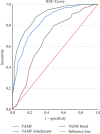Design and Validation of an Instrument for the Evaluation of the Quality of Mother-Child Bond and Attachment: "Cuestionario Vínculo y Apego Materno-Filial" (VAMF Questionnaire)
- PMID: 40224841
- PMCID: PMC11918938
- DOI: 10.1155/2024/6384511
Design and Validation of an Instrument for the Evaluation of the Quality of Mother-Child Bond and Attachment: "Cuestionario Vínculo y Apego Materno-Filial" (VAMF Questionnaire)
Abstract
The relationship between a mother and her newborn can be determined through two concepts: "bond" and "attachment." Currently, there are no instruments that assess these phenomena jointly. Objective. This study aims to develop a valid and reliable instrument to determine the quality of the postnatal bond and attachment in the mother-child relationship. Methods. In Spain, a multidisciplinary panel of experts was involved in creating the "Maternal-Child Bond and Attachment (VAMF, for its initials in Spanish)" tool. The tool was piloted on a group of women and applied to the target population of women with children aged between 6 weeks and 18 months to determine the psychometric characteristics: internal consistency Cronbach's α was used. An exploratory factor analysis was conducted, a study of convergent validity with the scale and predictive validity with the Maternal Postnatal Attachment Scale (MPAS) using Pearson's correlation coefficient, and a study of reliability was carried out using the intraclass correlation coefficient. Results. 1155 women participated, with a mean age of 34.5 years. The VAMF showed good internal consistency for the scale with 29 items (α = 0.836). In the exploratory factor analysis (EFA), an explained variance of 49.71% was observed with 6 components. Convergent validity showed an adequate correlation, with a Pearson correlation coefficient with the MPAS scale of 0.679. The VAMF questionnaire presented an excellent predictive capacity in the bond subscale, with an area under the ROC curve of 0.90 (95% CI: 0.87-0.93), and a poor predictive capacity in the attachment subscale, with an area under the ROC curve of 0.69 (95% CI: 0.63-0.76) to predict MPAS scale scores. In the test-retest, the VAMF presented a very good adequate degree of absolute agreement (ICC: 0.86; 95% CI: 0.72-0.93). Conclusions. The VAMF is a new valid and reliable instrument for determining the quality of the mother-child bond and attachment.
Copyright © 2024 Maria Antonia Diaz-Ogallar et al.
Conflict of interest statement
The authors declare that they have no conflicts of interest.
Figures
Similar articles
-
Psychometric properties of the Maternal Postnatal Attachment Scale and the Postpartum Bonding Questionnaire in three German samples.BMC Pregnancy Childbirth. 2024 Nov 26;24(1):789. doi: 10.1186/s12884-024-06964-4. BMC Pregnancy Childbirth. 2024. PMID: 39592992 Free PMC article.
-
Factors related to a disturbance in the mother-child bond and attachment.J Pediatr Nurs. 2024 May-Jun;76:114-123. doi: 10.1016/j.pedn.2024.02.009. Epub 2024 Feb 20. J Pediatr Nurs. 2024. PMID: 38377918
-
Psychometric properties of the Postpartum Bonding Questionnaire and correlates of mother-infant bonding impairment in Italian new mothers.Midwifery. 2017 Dec;55:15-22. doi: 10.1016/j.midw.2017.08.011. Epub 2017 Sep 1. Midwifery. 2017. PMID: 28915376
-
Cross-cultural adaptation and validation of the psychometric properties of the Quality from the Patient's Perspective I Questionnaire translated into Spanish.Midwifery. 2017 Dec;55:75-82. doi: 10.1016/j.midw.2017.09.005. Epub 2017 Sep 14. Midwifery. 2017. PMID: 28961471
-
The Mother-Newborn Skin-to-Skin Contact Questionnaire (MSSCQ): development and psychometric evaluation among Iranian midwives.BMC Pregnancy Childbirth. 2014 Feb 24;14:85. doi: 10.1186/1471-2393-14-85. BMC Pregnancy Childbirth. 2014. PMID: 24564830 Free PMC article.
Cited by
-
Prevalence and associated factors of anxiety in postpartum women.Eur J Midwifery. 2025 Jun 12;9. doi: 10.18332/ejm/204308. eCollection 2025. Eur J Midwifery. 2025. PMID: 40510437 Free PMC article.
References
MeSH terms
LinkOut - more resources
Full Text Sources


